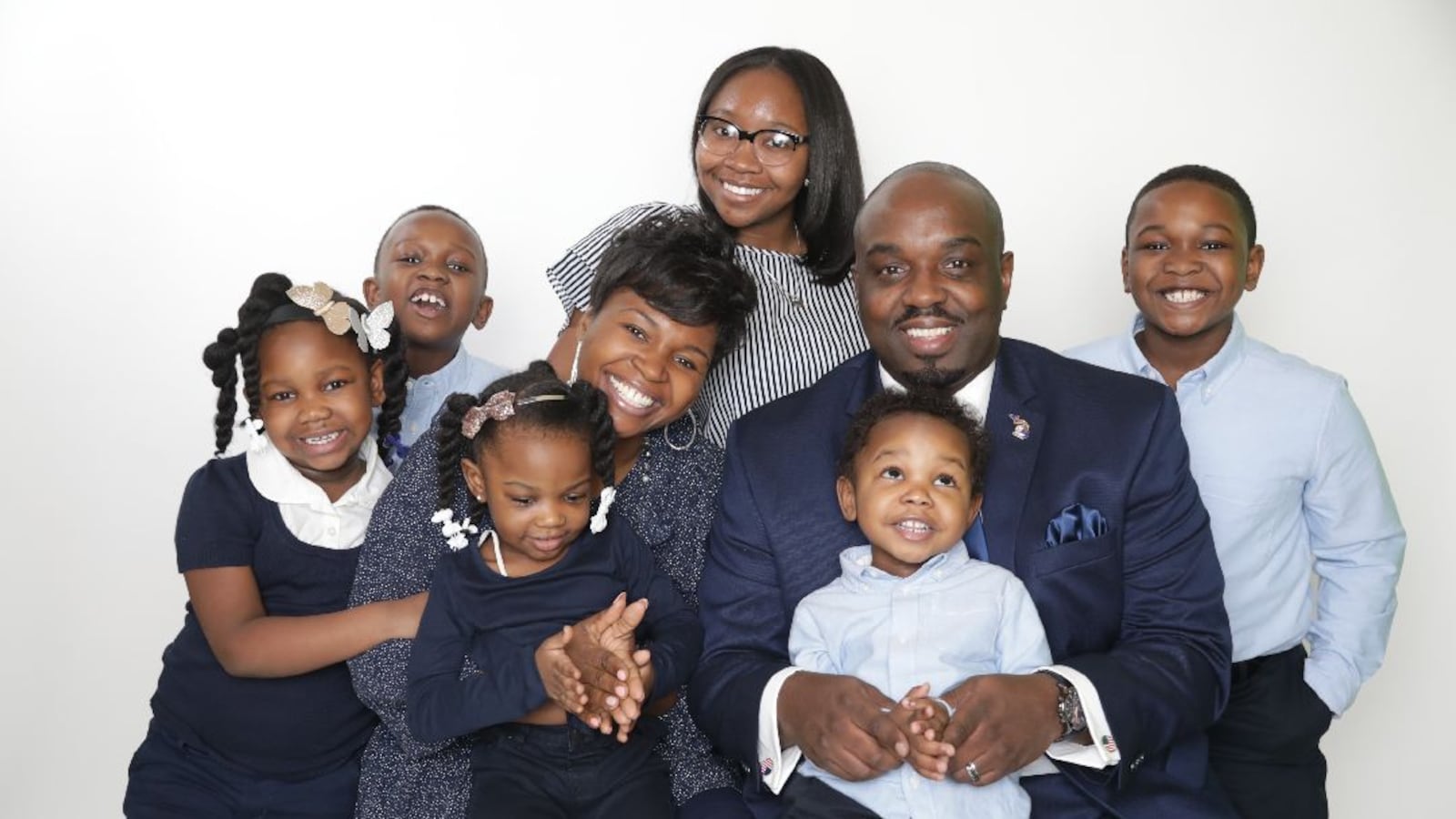Nicole Maloy has been trying to get her son Alexander into a preschool that can address his speech delay since the day he turned 3.
When he was younger, he was in a program called Early On that works with babies and toddlers who have special needs. When he’s older, he’ll be in a kindergarten program where teachers will be required by law to make sure he gets what he needs.
But right now he’s 3 and, in Michigan, there’s no clear path for parents trying to get special services for their 3- and 4-year olds.
That’s because the state’s lumbering process for transitioning 3-year-olds with special needs and disabilities into early childhood intervention programs is rife with miscommunication, lack of easily accessible information, and a shortage of spaces for 3- and 4-year-olds.
For the state’s estimated 13,000 preschoolers with special needs, it’s more difficult for parents to find places that will accept their children than it is for other preschoolers, said Richard Lower, the state’s director of preschool education.
In fact, there is a shortage of spots for all the state’s preschoolers. But “when you have a subset of 3-year-olds with disabilities, it’s even harder for them to find care,” said Lower. “It’s not impossible, but it’s hard.” Early On is the state’s early intervention program for children with special needs from birth to 36 months.
Parents often are confused by the options, or they just don’t know what the options are.
Experts and advocates call this time between Early On and kindergarten a gap – the lack of adequate seats, services, and widely available education for 3- and 4-year-olds with special needs.
There is no one program in Michigan that will accept all 3- or 4-year-olds regardless of the severity of their disability. Depending on eligibility and availability, parents can opt for the state-funded Great Start Readiness Program for 4-year-olds from low-income families, and the federal Head Start program, which accepts 3- and 4-year-olds with special needs regardless of income.
The local district can help evaluate a child with special needs, obtain a diagnosis, and place the child.
Parents are desperate for better resources to figure out how to best help their children obtain the critical early education they need to be kindergarten ready. Studies show that the impact of early education extends through their lifetime, determining kindergarten readiness, third-grade reading proficiency, school attendance, high school graduation rates, and even income-earning potential in adulthood.
As they grow older, children with special needs who successfully receive early intervention services may not need to be in special education classes in school, studies show. Early On, at its best, reduces the number of children who need special education services when they reach school age.
A recent annual federal education report ranked Michigan among the nation’s worst for serving children with special needs starting at age 3, and said the state “needs intervention,” the second lowest ranking in the report. That, combined with a special report from Lt. Gov. Brian Cally’s office last year that found schools are shouldering $700 million a year to pay for services for children with special needs that are not funded by the state, contribute to mounting evidence that Michigan is failing children with special needs.
Although Gov. Rick Snyder successfully pushed to include an extra $5 million for Early On in next year’s state budget, no new funds were added for children older than 3.
“This is a statewide issue,” said Marcie Lipsitt, a parent advocate and consultant who helps families in southeastern Michigan navigate the complex special education system.
“There just isn’t enough support or funding for families of children with special needs,” she said. We need more capacity and more outreach for families.”
Lipsitt and other advocates said although systems already are in place, obtaining a transition plan from Early On or a local district often is where the system breaks down.
If a child is enrolled in Early On, district staff called coordinators help parents develop a transition plan to enroll their children in preschool, but it’s up to the parents to make sure the meeting happens.
The meeting is crucial, because coordinators also work with parents to set up appointments with therapists, doctors, and specialists.
Caryn Ivey, a parent advocate and co-director of Michigan Alliance for Families, said an array of issues may arise during the process that leave parents confused.
Some parents skip the transition meeting because they don’t understand its importance, she said. Parents may not understand the plan. Others don’t act quickly enough after the meeting; waiting for benchmarks like a formal evaluation and a diagnosis can take time, sometimes months.
If the child is not enrolled in Early On, parents should contact their local or intermediate school district. The process is similar. The district would help create an IEP, or an individualized education program for the child. The IEP describes any services, accommodations, or therapies the child may need. District staff would also help get a diagnosis for the child, and then take steps to enroll the child in preschool.
To prevent delays, Ivey advises parents to speak to their home school district as soon as possible.
“That could be as simple as writing a letter to the home school district and asking a question: ‘My child just finished Early On, what should I do?’ ” she said.
This helps explain why Maloy’s struggle is not unusual. Before it was time for Alexander to graduate from Early On, she met with a transition coordinator in Detroit’s main district — a meeting all parents in the program should expect to happen six months before the child’s third birthday.
Alexander doesn’t have a formal diagnosis for his suspected autism and delayed speech. But Maloy’s coordinator scheduled appointments with specialists to evaluate him, and set up his education plan to accommodate his special needs. Maloy followed through on the appointments and received his individualized plan, but the Detroit school district doesn’t have a summer preschool program. Maloy must wait until fall to enroll him, leaving at least a five-month gap in his education.
Also, to enroll him, she needs a diagnosis, which so far she said she hasn’t been able to get. Although some specialists she spoke with were hesitant to diagnose Alexander before his fourth birthday, others shared he could have been diagnosed as early as 18 months.
In the midst of this, Maloy feels her son is losing valuable time.
“I really want him to go somewhere as soon as possible so he can get the help that he needs,” she said.
Maloy thought the process would be faster and her son would be in school by now. While she waits for school to start in the fall, she is homeschooling Alexander and investigating other options for care.
She, like many parents with children who have disabilities, didn’t know Head Start was an option.
Head Start, a free federally funded program for children from low-income families, will accept children with special needs no matter their income. That means it may be a good choice for families who need a slot for their young sons and daughters.
In Head Start, children with special needs attend classes with other students, and they are given a formal assessment and a diagnosis soon after they apply for admission. While other parents may wait indefinitely, it typically takes up to two months at Head Start, saving parents time, and ensuring that necessary steps aren’t overlooked.
“We want to serve those children,” said Kate Brady-Medley, director of Head Start and Early Head Start for Starfish Family Services. Starfish is a social service agency that leads a collaborative of Detroit Head Start providers. Studies on Head Start show the program can influence everything from whether kids succeed in school, to whether they become smokers as adults.
“We have a federal mandate, and we’re trying always to have at least 10 percent of the children in our program have an identified, documented disability,” she said.
Children can miss valuable early intervention in school for a variety of reasons.
Stephanie Onyx successfully enrolled her daughter, Alexa, in preschool in her home district of Madison Heights with no disruptions, right after she graduated from Early On.

But she pulled Alexa out of the program after the first year because she was dissatisfied with its quality. Onyx was confident it would be easy to enroll Alexa in another program.
It wasn’t so easy.
Several districts turned Alexa away because they considered her disabilities — cerebral palsy, low muscle tone, and inability to speak — too severe.
“Nobody would take her, and it was heartbreaking in this day and age,” Onyx said. “They had special education programs that had openings, but they wouldn’t take her.”
By law, school districts within the same county have to accept children with special needs – no matter how severe the disability is – but when parents don’t know the law and can’t afford an attorney – this happens often, advocate Lipsitt said.
“When a parent makes a request, legally the school district has to request the parents consent for an evaluation or give the parents a reason they are refusing an evaluation,” she said.
If Onyx had made a formal written request for an evaluation and allowed a district to deny her in writing, Lipsitt said, she could have taken legal action.
Making the request is as simple as saying in a note to the district: ‘I am the parent of this child, and I am requesting a special education evaluation,’ ” and there is a 10-school-day time limit on that, ” she said.
When Onyx wasn’t able to get her daughter into a preschool, she gave up and homeschooled Alexa. The disadvantage of missing precious preschool time with other children became evident when Alexa, now 7, finally was accepted into kindergarten in the Troy district.
After a year of being homeschooled, she was not socially or emotionally prepared to attend school with her peers.
“That first year was a struggle — the entire year,” Onyx said. “We had a lot of meltdowns when she couldn’t get her way.”
Now, after just completing first grade, Onyx said Alexa is doing better and has fewer tantrums, but she still needs more time to catch up.
“She is able to learn and grow. She is able to progress,” Onyx said. “I knew that once in a program, she would progress, and I also know that she would be even further ahead had she been given that opportunity.”
New options could be opening for parents of 3-year-olds with special needs in the future, said Lower, the state’s director for preschool.
For the past few years under the Snyder administration, Lower said he’s researched and discussed with state legislators the possibility of expanding the Great Start Readiness Program, including possibly expanding it to 3-year-olds.
But it all comes down to money, he said.
If all the state’s 68,000 3-year-olds who fall at least 250 percent below the federal poverty level were included in such a program, and funding was calculated at the current per pupil rate of $7,250 for a 6- to 7-hour school day, the annual cost would be at least $493 million, he said.
That figure doesn’t factor in additional costs, including a required 1-to-6 teacher-student ratio, time for meal preparation, brushing teeth, and other activities throughout the school day that add costs to providing care for 3-year-olds.
Lower said a bigger investment in education is needed to increase the number of 3-year-olds in school.
“It’s a complex system that is not as fully developed as K-12, and it’s still being built in early childhood education. There are pieces that are great and high quality, and other pieces that are not as highly developed.”

